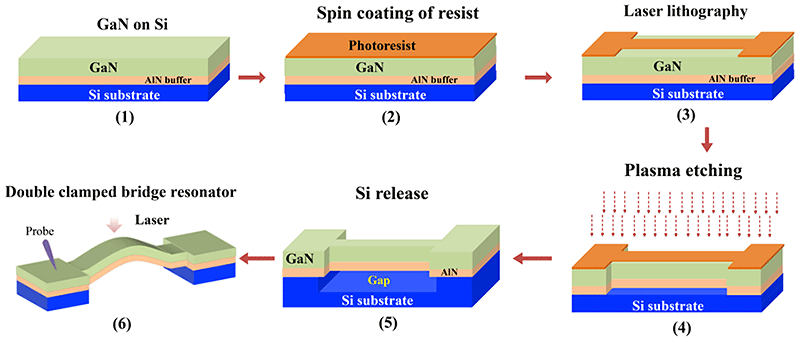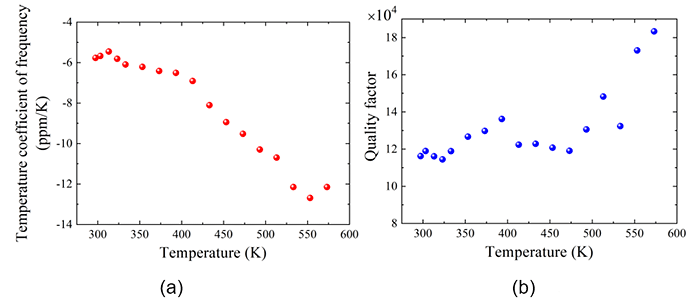Liwen Sang, independent scientist at International Center for Materials Nanoarchitectonics, National Institute for Materials Science (also JST PRESTO researcher) developed a MEMS resonator that stably operates even under high temperatures by regulating the strain caused by the heat from gallium nitride (GaN).
High-precision synchronization is required for the fifth generation mobile communication system (5G) with a high speed and large capacity. To that end, a high-performance frequency reference oscillator which can balance the temporal stability and temporal resolution is necessary as a timing device to generate signals on a fixed cycle. The conventional quartz resonator as the oscillator has the poor integration capability and its application is limited. Although a micro-electromechanical system (MEMS)*1 resonator can achieve a high temporal resolution with small phase noise and superior integration capability, the silicon (Si)-based MEMS suffers from a bad stability at higher temperatures.
In the present study, a high-quality GaN epitaxial film was fabricated on a Si substrate using metal organic chemical vapor deposition (MOCVD)*2 to fabricate the GaN resonator. The strain engineering was proposed to improve the temporal performance. The strain was achieved through utilizing the lattice mismatch and thermal mismatch between GaN and Si substrate. Therefore, GaN was directly grown on Si without any strain-removal layer. By optimizing the temperature decrease method during MOCVD growth, there was no crack observed on GaN and its crystalline quality is comparable to that obtained by the conventional method of using a superlattice strain-removal layer.
The developed GaN-based MEMS resonator was verified to operate stably even at 600K. It showed a high temporal resolution and good temporal stability with little frequency shift when the temperature was increased. This is because the internal thermal strain compensated the frequency shift and reduce the energy dissipation. Since the device is small, highly sensitive and can be integrated with CMOS technology, it is promising for the application to 5G communication, IoT timing device, on-vehicle applications, and advanced driver assistance system.
The research was supported by JST’s Strategic Basic Research Program, Precursory Research for Embryonic Science and Technology(PRESTO). This result was presented at the IEEE International Electron Devices Meeting (IEDM2020) held online on December 12-18, 2020, titled “Self-Temperature-Compensated GaN MEMS Resonators through Strain Engineering up to 600 K.”
(1)Micro-electro mechanical systems (MEMS)
A device where mechanical components, sensors, actuators, and electrical circuit are integrated on a substrate, such as semiconductor, glass, or organic material through microfabrication technology. For the main component, three-dimensional shape and movable structures are built through etching.
(2)Metal organic chemical vapor deposition (MOCVD)
A useful crystal growth method to build a wafer for compound semiconductors. Organometallic compounds of the Group III and Group V are simultaneously provided to the heated crystalline surface of the substrate to achieve epitaxial growth.
-

Figure 1. The device processing for the double-clamped GaN bridge resonator on Si substrate
Figure Caption:(1) The as-grown GaN epitaxial film on Si substrate. Except for the AlN buffer layer, no strain removal layer is used.
(2) Spin coating of the photoresist on the GaN-on-Si sample.
(3) Laser lithography to define the pattern for the double clamped bridge configuration.
(4) Plasma etching to remove the GaN layer without photoresist.
(5) Chemical etching to release Si under the GaN layer. Therefore, the air gap is formed.
(6) The final device structure of the double clamped bridge resonator. We use the laser doppler method to measure the frequency shift and resolution under different temperatures.
© Liwen Sang
-

Figure 2. (a) The temperature coefficient of frequency (TCF) of the GaN resonator at different temperature; (b) The quality factor of the GaN resonator at different temperature The temporal stability of a resonator is defined by temperature coefficient of frequency (TCF). TCF indicates a change of the resonance frequency with changing temperature. For the Si MEMS resonator, its intrinsic TCF is ~ -30ppm/K. Several methods were proposed to reduce the TCF of Si resonator, but the quality factors of the system were greatly degraded. The quality factor of a resonator in the system can be used to determine the frequency resolution. A high quality factor is required for the accurate frequency reference. The developed GaN resonator in this work can simultaneously achieve a low TCF and high quality factor up to 600 K. The TCF is as low as -5 ppm/K. The quality factor is more than 105, which is the highest one ever reported in GaN system. © Liwen Sang
Program Information
- JST PRESTO
- Research Area “Thermal Science and Control of Spectral Energy Transport”
- Research Theme “Optimizing the interface phonons transport for thermal dissipation through polarization field engineering”
Contact
-
[About Research]
SANG Liwen
International Center for Materials Nanoarchitectonics,
National Institute for Materials Science
TEL:+81-29-860-4970
E-mail: SANG.Liwennims.go.jp
-
[About Program]
Shimabayashi Yuko
Department of Strategic Basic Research, JST
E-mail: prestojst.go.jp
